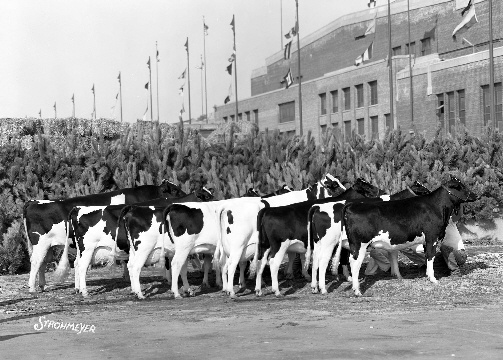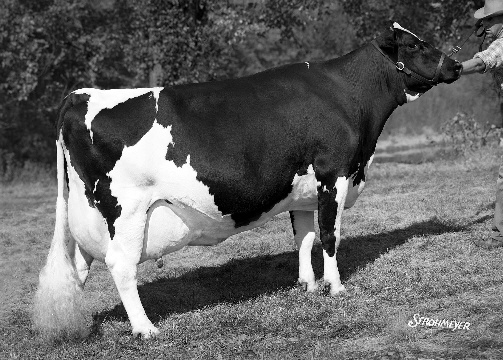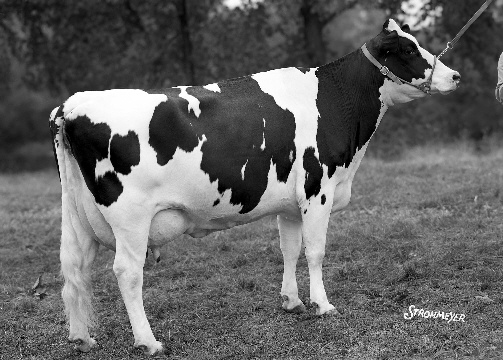By Norman Nabholz
You could almost call the Wisconsin State herds in the Holstein breed at Waterloo unbeatable, almost.
All the parts of the puzzle fit together with a seemingly endless supply of great cattle and some of the greatest caretakers that went with them. It was a splendid combination; Crescent Beauty, Pabst, Brauns Sunny Lea, Gray View, Lakeside, The Mayers would all contribute not only cattle but the talent in preparation as well. For most, it was a short truck ride in the ‘60s and a stop on the circuit via box car before that. The State herd class would be plotted during the Wisconsin State Fair which, in the glory years, was one of the largest and most competitive Holstein shows of it’s time. In later years there was the Wisconsin Black & White show and the Waukesha dairy show as well.

Wisconsin State Herd
Pabst Farms would contribute the Grand Champion Bull, Pabst Forbes Burke, in 1955-56-57.
Pabst Forbes Burke
Talk about style, this bull had it from end to end. (A note on “Forbes Burke” after he was Grand in 1957 he was led back to his stall where he “pitched Elis Knutson over the partition catching him with a horn under the leg. Elis visited the hospital the next morning for what was diagnosed as strained ligaments but Hoard’s Dairyman reported Elis still walking with a limp at Chicago the next week. It could have been a whole lot worse)
The last day of Waterloo in 1957 was the presentation of the herdsman awards and the Klussendorf before the group packed up and headed to Chicago. Elis Knutson would have his name engraved on the trophy as the winner. What a memorable week for the popular herdsman and his friends from Wisconsin.
1957 Klussendorf winner, Elis Knutson, in the center of these Klussendorf winners.
Pabst would be a large contributor to the state herd and usually they would max out with the three head allowed from one exhibitor.
Pabst Prime
One of the great bulls bred by Pabst was Pabst Prime, who was a winner in 1957 for his new owners, the St. Croix County Hospital.

Plain View Inga
Perhaps their greatest contribution was their Grand Champion cow, Plain View Inga, who won that honor in 1956 at Waterloo as well as--dig this--the Wisconsin State Show the state fairs in Wisconsin, Ohio and Indiana, the Royal Winter Fair and the Chicago International. Now that was some kind of show circuit and she never saw the back end of a cow, starting in July and ending in November and the same should be said of Forbes Burke who showed at all but the state show.
Pabst was always good for a young animal as well. The farm would also launch the career of one of the most colorful and popular men to grace the tanbark in Elis Knutson and several great cow people including, but not limited to, Sylvester Weiler, Russ and Butch Ridge and more. Books have been written about Pabst and their great accomplishments. The advancement of the Holstein cow always came first at Pabst. It is interesting that Henry Uihlein of Heaven Hill Jerseys and Joseph Schlitz brewing company was a relative of Fred and David Pabst and their Blue Ribbon beverage company. Both were highly successful as cattle breeders and promoters of their herds--one in New York and one in Wisconsin.
The year of 1957 was a year which would be hard to duplicate for Wisconsin Holstein breeders. The judge for the show was W.K. Hepburn Jr., who was judging nearly all the big shows of that time. There were 293 head of Holsteins shown and the dairy state won 13 firsts and the next closest state for blue ribbons would be Illinois with 3. The aforementioned Forbes Burke was Grand Champion bull and Da-Co Ton Crescent Fannie was Grand Champion female for Allen Hetts In the state herd of ten head, Wisconsin had eight blue ribbon winners to use including the Grand Champion, the first dry cow & Reserve, a huge dairy cow bred in Indiana and owned by Sunny Lea. Her name was Wimpy and she would have her day in the sun in future Waterloo shows.
Linden Dictator Wimple Wimpy
Linden Dictator Wimble Wimpy was bred in Indiana and if there was ever a more perfect frame on a dairy cow, nobody had seen it yet and most haven’t seen it since. Huge and good. They didn’t measure cows in those days like they do now but those who saw her say she scared 64 inches with as long a rib as ever put under a black and white hide. She was spotted at Chicago the year before (1956) and purchased from her owners, the Newmans from Indiana. Wimpy and her associates must have felt like it was a homecoming of sorts as she was sired by an Iowa bred bull, Maytag Ormsby Fobes Dictator who was bred at Maytag some 97 miles from the Cattle Congress grounds and fitted, fed, washed, milked and shown by Nelson Rheder of Gladbrook, Iowa which is almost in the middle between Waterloo and Newton some 39 miles from the Cattle Congress.
Wimpy would become a rare three time Grand Champion, her first in the next year in 1958. Later “Rheder” would buy his beloved Wimpy in the Sunny Lea sale and she would be Grand Champion for him in 1960 and 1961.
The Mayer’s from Southern Wisconsin would remember 1957 forever.
Sr. Get Creston Grand Majesty - 1957 Christ Mayer.
Mayers Mistress Dark Anna -1957
The Mayers Family
This farmer breeder herd would take on the titans and be named Premier Breeder and Exhibitor at Waterloo and win four firsts, three seconds and a third. Quite an accomplishment for a farmer breeder herd and one of those stories that would filter in each year at Waterloo, where the people of means, Pabst, Hayseen, Maytag, Curtiss, Franlo, Carnation, Elmwood, Romandale etc., would meet up with the farmer breeder, the man that planted and harvested his own feed, baled his own hay, milked his own cows as in Mayer’s, Hetts, Nelson, etc. Of note, Mayers would repeat as Premier Breeder in 1963 as well. It is what made for an exciting, one of a kind show that people started planning on when they attended their first district or county show in July or August and reached a fevered pitch by the last week of September. It was Waterloo time.
Wisconsin & Gray View are names that go hand in hand and throughout the years of Wisconsin state herd dominance, Gray View would be front and center most generally with multiple animals in the State Herd.

Gray View BD Skyanne
Gray View BD Skyanne (Ex-96) was a two time Waterloo Grand Champion in 1954 and 55 and would anchor the State herd both years and was the dam of one of the prettiest bulls ever and one of the most expensive at the time as well, the All American Gray View BD Skyliner, who was sold for a large sum to Curtiss Breeding service.
Gray View Skyliner
Who could forget Gray View Criscross, a 4X All American and the All Time All American aged bull?
Gray View Crisscross
Crisscross was a bull who took a while to grow into himself. He started as fifth place Junior Yearling at Waterloo, then second as a young 2 year old and became almost unstoppable as a show bull. Crisscross was Grand at Waterloo in 1963 defeating Romandale Reflection Marquis and stood on the end of the state herd and Gray Views display. It just so happened when he was in his glory so were “Marquis” and Boontuck Ormsby Pat., all great, all over 3,000 lbs and near 70 inches at the shoulder. Nevertheless Gray View would always supply much needed ammunition for the state herd especially at the last National show at Waterloo where Gray View would win six blue ribbons and would be rewarded with the last Premier Breeder Banner from a National show at Waterloo. Together with Ray Brubacher’s Lakeside high placing animals and the winning 4 year old cow from Ralph Draeger’s of Fort Atkinson and a animal from Bristol Farms Wisconsin would take the State Herd Banner back to their home office. It had to be a little close with Illinois placing second of the nine groups in the hippodrome anchored by the Premier Exhibitor group of Chambric Farm and managed by Elis Knutson coming back to at least scare his old buddies from Wisconsin. Close but no cigar, Elis.